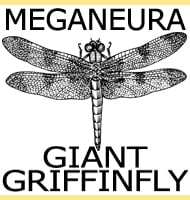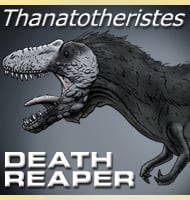Stegosauruses are among the most iconic dinosaurs, renowned for their distinctive back plates and spiked tails.
While they are often imagined as towering giants, the Stegosauria family actually includes a fascinating range of species varying significantly in size.

Here in this article we will be highlighting both the well-known behemoths and the smallest stegosaurus species ever discovered. From the primitive Huayangosaurus to the diminutive Chungkingosaurus,

10 – Dacentrurus

With fossils recovered from England, Dacentrurus was one of the first stegosaur genera to be established in Europe, though the situation is a little muddy.
The first Stegosaur genus to be described in Europe (and again from England) was Regnosaurus, though the very limited remains from which the genus was described has since led to many questioning the validity of that genus.
Then in 1874 another genus named Craterosaurus was named (again in England), but again from scant fossil remains, and these may actually be from Regnosaurus, which itself is dubious.
Dacentrurus was named one year later but as Omosaurus, a name that had already been given to a genus of crocodile, hence the name change to Dacentrurus in 1902.
Really Dacentrurus is the first genus of Stegosaur to be named and established upon good fossil remains, which means that the validity of the genus is not in doubt.
Dacentrurus is the type genus of the Dacentrurinae which includes most European stegosaurs. It was also nearly the type genus for the group known as the Stegosauria since it was first described in 1875, two years before Stegosaurus.
However since the name was preoccupied it does not have validity to name a group, and so Stegosaurus became the type genus instead.
9 – Chungkingosaurus

Chungkingosaurus is possibly one of the smallest stegosaurs known to exist, being less even than half the size of its more famous and larger cousins.
Chungkingosaurus lived in China at a time when many other genera of stegosaurs are known to have existed.
8 – Huayangosaurus

The first of the Chinese stegosaurs on this list, Huayangosaurus is credited with being one of the most primitive stegosaurs that we know about.
So primitive is Huayangosaurus, that the premaxilla (the forward tooth bearing bone of the skull) still has teeth.
In more advanced forms these teeth were lost in favour for a snipping keratinous beak.
Huayangosaurus was not particularly huge, and is also noted for having spines that are more like spikes.
7 – Chialingosaurus
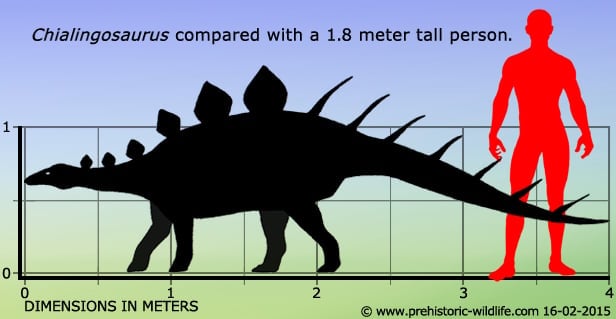
Named in 1959, Chialingosaurus was the first genus of stegosaurid dinosaur discovered in China, but is now just one of many known to come from this part of the world.
Some Fossils of Chialingosaurus are thought to date back to about 160 million years ago, making, Chialingosaurus one of the oldest stegosaur genera.
The smaller size of Chialingosaurus may be indicative of more humble beginnings for the stegosaurs, steadily growing larger as the Jurassic went on.
6 – Miragaia
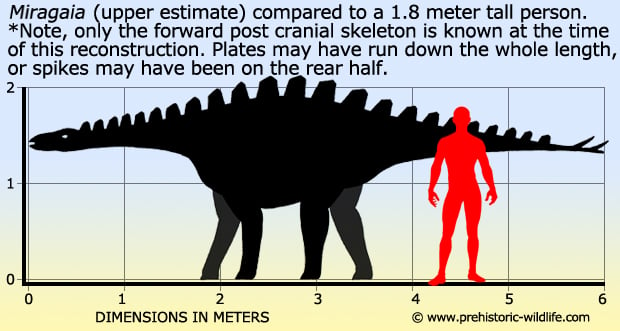
Miragaia is most notable for its proportionately long neck, something that is quite unusual for a stegosaur.
It is unknown why the neck of Miragaia should have been longer, but perhaps it was for a slightly different feeding strategy, such as sweeping the head over a wider area without having to move the body like in a low browsing sauropod.
Palaeontologists also consider Miragaia to be closely related to the aforementioned Dacentrurus, and together they are often included within the Dacentrinae sub group of the Stegosauria.
5 – Tuojiangosaurus

Easily the best preserved of the Chinese stegosaurs, Tuojiangosaurus was fairly large for a stegosaur, though certainly not ‘the’ largest.
The plates on the back of Tuojiangosaurus were arranged in pairs than ran in two rows down the back.
These plates were fairly tall and pointed, making them quite distinctive when compared to other stegosaurs.
4 – Gigantspinosaurus
Many of the Chinese stegosaurs were small at around the four meter mark, and in this Gigantspinosaurus was no exception.
What does make Gigantspinosaurus stand out however are the huge spines that grew from the shoulders.
These might have provided additional defence against predators that tried to circle around to attempt an attack on the head.
3 – Wuerhosaurus
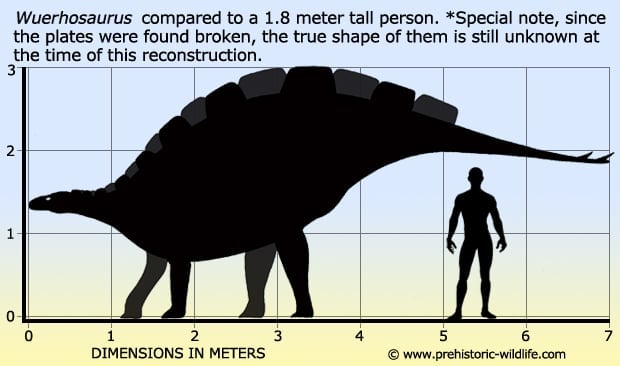
Wuerhosaurus was fairly big for a stegosaur and is known from both China and Mongolia. What is really significant about this Stegosaur is that it lived during the early Cretaceous.
Most other stegosaur genera are known from the earlier in late Jurassic, which means that Wuerhosaurus is one of the latest surviving stegosaurs that we know about.
The first reconstructions of Wuerhosaurus show the plates on the back to be quite low, but it has now been proven that this is a result of the plates being damaged, perhaps as a result of animal rolling over on its back after death. The true form of these plates is still not currently known.
2 – Kentrosaurus
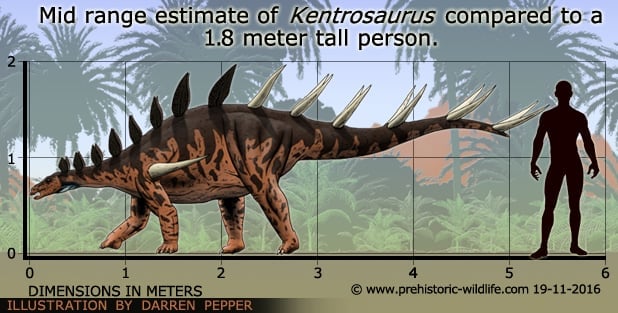
One of the oldest and best known of the stegosaurs, Kentrosaurus was one of the earliest examples to show how different the plate and spike arrangement of stegosaurs could be.
Only the anterior (front) of the back has plates, the rear half has paired spines running down all the way to the end of the tail.

Kentrosaurus lived in North Africa during the late Jurassic which had a similar mix of dinosaur types as what North America and Asia had during this time.
Like with some other smaller stegosaurs, two exceptionally large spines grew from the shoulders.
1 – Stegosaurus

Well technically it might not be the first named stegosaur, but it is the one that started it all for the wider public’s perception of these bizarre looking dinosaurs.
It took some time however to figure out how the plates on the back were arranged since the plates don’t actually articulate to the skeleton directly.
When Othniel Charles Marsh first named Stegosaurus in 1877 he thought that the plates might have been arranged flat on the back like the tiles on a roof, so he came up with the name Stegosaurus which actually means ‘roof lizard’.
It was not until a three dimensionally preserved specimen with the plates in the upwards pointing orientation was found that reconstructions began to be a little more accurate.
Still, early reconstructions had the plates arranged in rowed pairs, but the problem with this is that the plates that correspond to an individual are always of different sizes with no matching pairs.
We now know that the plates were arranged in an alternating row down the back, so that when viewed from the side they would be very little daylight showing between them.
Most stegosaur study has been cantered upon Stegosaurus thanks largely to the wealth of known fossils for this genus.
The function of the plates has probably been the longest concern about Stegosaurus with theories ranging from defensive armour to thermoregulation.
Today the most likely function of them is thought to be display since they are not particularly well suited to either of the other functions, and the look and arrangement between species and genera is different, suggesting a need for species recognition.
Stegosaurus is the largest known stegosaur, with many specimens approaching nine meters in size, though some fossils indicating that some individuals may have been slightly larger than this.
Stegosaurus is also one of the few truly transatlantic dinosaurs with most known individuals being found within the USA, but at least one specimen being discovered in Portugal in 2006.






